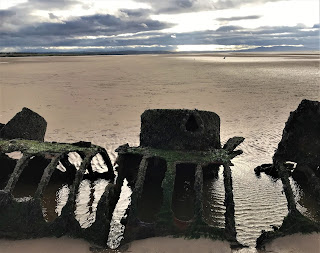About a mile away from the picturesque village
of Aberlady, there is a rather lovely walk through a nature reserve that
stretches along the coast on one side of Aberlady Bay. The path through this takes you through a
wooded area and out onto a stretch of land covered in sea grasses and reeds. From there it leads onto some huge sand dunes
and a gorgeous sandy beach that seems to stretch out forever at low tide. Today, I walked out there from Aberlady. The sun shone through a wind that howled in
from the sea and it was both warm and freezing at the same time. Typical British beach weather basically.
As I made my way out along the beach
towards the retreating sea, I took off my socks and shoes and walked though
pitted puddles in the sand to the watery graves of two submarines.
These are not as you may think German
submarines sunk during World War II but are rather a couple of British mini
submarines that were used by the RAF for target practice.
They are the remains of two XT-Craft
midget submarines. These are training
versions of the X-Craft submarines which were built in Britain during the
Second World War and were designed to defend harbours and attack targets. They were used on the attack of the German
battleship Tirpitz in 1943 and were used during the D-Day landings to carry out
beach reconnaissance and act as navigational beacons.
In 1946 these two submarines were towed
out to Aberlady bay and moored to concrete blocks. They were then used to test the effectiveness
of 20mm cannon shells, which were fired at them by RAF aircraft. The film of these tests taking place is
available on YouTube at –
After the tests were completed the damaged remains of the submarines were left to rust away in the sea.
I left the Skulferatu that accompanied
me on my walk in a hole in the rusting interior of one of the submarines.
The coordinates for the location of the Skulferatu
are –
Latitude 56.022681
Longitude -2.880941
I used the following sources for information on the submarines –
Canmore
X-craft: Aberlady Bay,
Firth Of Forth | Canmore
Aberlady Heritage
Midget Submarines,
Aberlady Bay, Summary Report by Alison Boutland














No comments:
Post a Comment